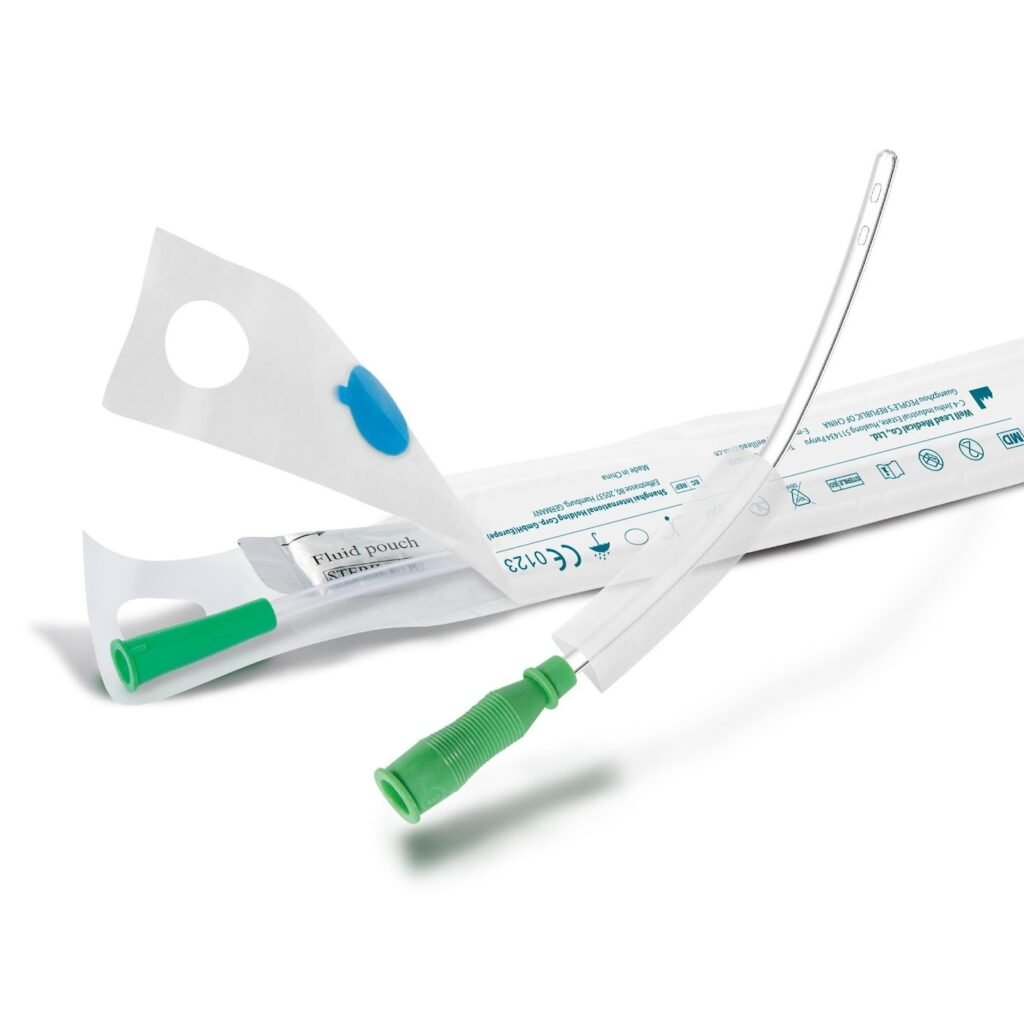Urinary tract infections (UTIs) due to catheterization are one of the most common types of healthcare-associated infections. These infections account for more than 1 million cases per year in the United States alone[1]. If you compare indwelling vs. intermittent catheter, you’ll find that intermittent catheters have a significantly lower risk of UTIs. They are indicated for patients who have neurogenic incontinence or Urinary retention.
Intermittent catheters are disposable tubes inserted into the bladder to remove the urine. Once the bladder is empty, the catheter is removed and discarded. They often come in sterile packaging containing hydrophilic catheter tubing. This article provides you with a simple guide to understanding different types of intermittent catheter supplies and how to use them properly.

3 Common Types of Disposable Intermittent Catheters – By Surface Treatment and Lubrication
When you are out there in search of an intermittent self-catheter, you’ll come across three different types of these intermittent catheter supplies available in the market:
- Pre-lubricated intermittent catheter
- Hydrophilic intermittent catheter
- Uncoated intermittent catheter
Here is a detailed overview of each of these:
- Pre-lubricated / Ready-to-use Intermittent Catheters
Pre-lubricated catheters are ready-to-use catheters covered in sterile, gel-like lubricant. They are made for single use and can be used instantly straight out of the packaging. Pre-lubricated catheters provide you with the following advantages:
- They are convenient and can be easily inserted
- Great for outside home catherizarion or during emergency situations
- There is less preparation time, as there is no need to apply an outside lubricant
- These catheters have much lower chances of contamination
- Hydrophilic / Water-activated Intermittent Catheters
Hydrophilic catheters come with a proprietary coating. It reacts with water in the unopened packaging and self-lubricates the catheter. These catheters are popular because of their minimal friction during insertion and withdrawal. It makes the whole process comfortable, and there is less risk of urethral trauma involved.
Most of these catheters come packaged with a sterile water sachet. It makes it easier to activate the coating 30 seconds before use. People who have to catheterise very often can benefit from hydrophilic catheters as they are ideal for long-term comfort and safety.
- Uncoated / Dry Intermittent Catheters
These are traditional intermittent catheters. They do not have a pre-lubricated or hydrophilic coating, so an external lubricant must be applied manually before use. The main advantages of this type are its simplicity and lower cost.
Unlock comprehensive knowledge about intermittent catheters and discover the right products for you. Visit Well Lead Medical: Intermittent Catheter (for ISC)
Other Classifications (Overview)
Besides the surface treatment and lubrication, intermittent catheter supplies can be categorised by tip, length, design, and user type. Here are a few examples:
- Catheter Length
Depending upon the anatomical differences between the male and female urethral length, catheter types have now become more gender specific.
- Standard length of intermittent catheter males is ~40-45cm (16″)
- For intermittent catheter females, the length ranges from 20-26cm (6-12″)
- Length for pediatric is 6-10″
- Tip Design
Straight tip catheters are standard and are most commonly used. However, Coudé tip catheters (slightly curved at the end) are recommended for patients with enlarged prostates or urethral strictures.
- Packaging Style
Some catheters come with compact packaging. However, some catheters are packaged individually, so they are easier to carry around. The packaging also resembles cosmetic products, so you can store it discreetly.
Intermittent Catheterization Procedure Guide
- Preparation Phase
For the preparation phase, carefully follow these steps:
- Wash your hands thoroughly with soap and water.
- Prepare all necessary intermittent catheter supplies: catheter, lubricant (if needed), and disinfectant wipes.
- Make sure that your environment is clean to minimize infection risks.
- Step-by-Step Procedure (General Guide)
- Wash and dry the genital area with a clean wipe.
- Open the catheter package carefully without touching the insertion end.
- Lubricate the catheter if it is uncoated, or activate the hydrophilic coating if applicable.
- Gently insert the catheter into the urethra until urine begins to flow.
- Allow urine to fully drain into a toilet or collection container.
- Once drainage stops, you can slowly withdraw the catheter.
- Dispose of the catheter properly after single use.
- Precautions
- Make sure that you always use sterile and single-use catheters to avoid infections.
- Avoid force during insertion. If resistance occurs, consult your healthcare provider.
- Follow medical guidance about the frequency of catheterization, as it depends upon the patient’s condition.
ConviCath® Series Intermittent Catheters by Well Lead Medical
Well Lead Medical, providing high-quality and innovative medical solutions, has been a trusted global provider of medical equipment and supplies since 1998. They offer a comprehensive range of intermittent catheter supplies under their ConviCath® Series. These products are designed to meet a range of patient needs with a focus on safety, comfort, and convenience.
If you are looking for reliable and high-quality solutions in the field of medical equipment supplies, Well Lead Medical is the answer.
References:
[1] Catheter-Associated Urinary Tract Infections: Current Challenges and Future Prospects. Available at: https://pmc.ncbi.nlm.nih.gov/articles/PMC8992741/ (Accessed: 10 September 2025)


